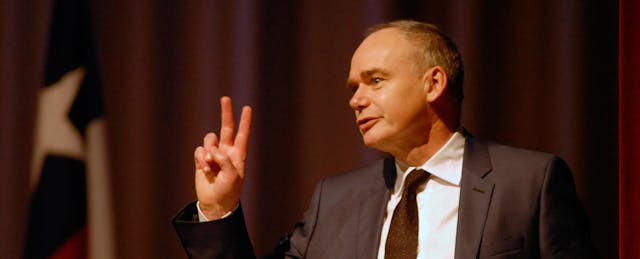There’s a job opening for a CEO at a global education company with a $6.6 billion market value.
Pearson CEO John Fallon today announced plans to retire in 2020 after a successor has been appointed. Sidney Taurel, chairman of the company’s board of directors, is leading the search for the next chief executive.
It will mark the end of a dramatic, and at times tumultuous, tenure for Fallon. For the past seven years, he sat in arguably the hottest of the hot seats in the education industry, tasked with changing the world’s biggest education brand from a largely print-based to digital-focused company.
The market has not reacted favorably to those efforts. Since Fallon became CEO on January 1, 2013, the value of Pearson’s stock on the New York Stock Exchange has dropped by 57 percent, closing at $8.45 at the time of writing. Most recently, the company warned investors that its U.S. textbook sales for 2019 would be weak.
“We’re now at the stage where it’s time to transition to a new leader, who can bring a fresh perspective,” Fallon said in a prepared statement. “As the Board works on my succession, I will continue to be completely committed to leading the company through this major transformation.”
Fallon succeeded Marjorie Scardino, who led Pearson during the previous 16 years. He joined Pearson in 1997, first as director of communication and later overseeing its international business operations.
Scardino was credited with turning Pearson into a behemoth, orchestrating more than two dozen acquisitions during her time. Part of Fallon’s job was to trim the legacy parts of the business and reorient the company around digital learning services. In an interview with EdSurge in 2013, he described his work as leading “the most significant restructuring in a decade or more.”
Fallon sold some of Pearson’s most widely known brands. The asset sales peaked in 2015, when Pearson sold the Financial Times to Nikkei, Japan’s largest media company, and its stake in The Economist to existing shareholders. Digital education assets were not spared, either. That same year, Pearson also sold PowerSchool, one the most widely used student information system in K-12 schools and districts today.
At the time, Fallon said PowerSchool was “an administrative system rather than a tool for learning, teaching or assessment,” and which did not jibe with Pearson’s transformation strategy.
The company offered a similar reason for selling its U.S. K-12 courseware assets, which Fallon described as “textbook-led” and one that “does not fit in with our digital transformation strategy.”
And the sales continue. In conjunction with announcing Fallon’s plans to step down, Pearson said that it will sell its remaining stake in Penguin Random House to Bertelsmann for $675 million. Pearson sold a 22 percent stake back in 2017.
Resuming Investments
Under Fallon, Pearson not only got rid of assets. The company’s restructuring effort has also reportedly reduced its staff by 16,000 over the past six years. Pearson’s website puts its current headcount at 24,000 employees.
Such cost-cutting efforts did not always help Pearson’s bottom line, though. It posted a $3.3 billion full-year loss—the biggest in its history—in 2016. And it has posted profit warnings on numerous occasions—as recently as this past September, citing “significantly weaker” sales in the U.S. higher education business that could erode its revenue by as much as 12 percent in 2019. The company’s stock has lost about a quarter of its value this year alone.
Today, Pearson is slimmer than it was in 2013, when Fallon took the helm. That year, the company posted a profit of £736 million on £5.2 billion in sales. In 2018, Pearson reported a profit of £546 million on £4.1 billion in sales.
Digital is driving a bigger part of Pearson’s business. The company reported that 62 percent of its revenues came from digital or digital-enabled services last year.
This summer, Pearson announced it would move away from its traditional practice of updating and reprinting new textbooks every two to three years and instead roll out all textbook updates first in the digital version. It has invested in artificial intelligence capabilities aiming to power new education tools, such as a calculus tutoring app released last month.
In the meantime, Pearson has rebooted some of its investment activities. It launched a $50-million venture fund this April and has invested in two education startups. And last month, the company scored its first acquisition in three years, putting down $27 million to buy Lumerit Education, a San Antonio, Texas-based company helps businesses offer their employees opportunities to earn bachelor’s degrees.
“In some very challenging markets, John has worked tirelessly leading Pearson through a period of significant change and led its transformation from a media conglomerate to a single focused learning company,” said Taurel, chairman of Pearson’s board, in a statement. “Under John’s leadership Pearson has become a simpler, more digital focused business underpinned by a stronger balance sheet and better positioned to deliver a sustainable and healthy future.”


